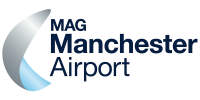RNP approaches to landing runways (23R, 05L and 05R) at Manchester Ringway Airport
Timeline
Description
The main objective is to implement Required Navigation Performance (RNP) final approaches to landing runways (23R, 05L and 05R) at Manchester Ringway Airport using Performance Based Navigation (PBN) as required by the Pilot Common Project (PCP) to enable removal of the VOR (Very high frequency Omnidirectional Range) ground-based navigation infrastructure. Landing runway 23L is already equipped with an RNP Approach procedure.
UK airspace is being fundamentally re-designed to improve efficiency and safety, through NATS NERL PLAS (Prestwick Lower Airspace Systemisation), which will better integrate Manchester Ringway Airport into the wider en-route network with higher efficiency. This project will close the identified gaps within family 1.2.1 for Manchester Ringway Airport.
The decommissioning of the legacy VOR ground based navigation infrastructure will result in the withdrawal of all Manchester's existing conventional non-precision approach procedures all of which are dependent on this facility. This VOR is located on the Manchester Airfield but is owned and maintained by NATS En-Route Limited (NERL). As part of the UK NERL VOR rationalisation programme there is a requirement to withdraw the Manchester VOR navigation infrastructure. Although precision approaches will still exist (primarily ILS) the proposed RNP approaches will guarantee safe approaches for non-precision equipped aircraft, and during times of system failure and maintenance.
The project team will need to indicate to the state regulator the intention to design and implement RNP based operations in line with the publication of the UK CAA CAP1616 procedures documentation. The RNP approach procedure design and public consultation will be conducted in line with this UK CAA guidance.
This procedure consists of six stages, and takes a minimum of 2 years to complete. This is due to the requirement to consider a full range of options in developing the design, to conduct full environmental analysis of all options and to consult with aviation and public stakeholders for a minimum of 3 months. There will be a significant investment in creating a team of 8-10 dedicated people with the specific skills to achieve the outcome, and also to develop and provide clear and concise communication materials and undertake public consultations as required by the regulatory process. There is also a requirement to conduct environmental impact studies as required identified by the scope of the project and the legislation.
Specific objectives:
The Implementation Project aims to:
Design and implement RNP approaches to landing runways 23R, 05L and 05R to LPV200 standard..
Publish the RNP procedures in UK AIP
Conduct a Public Consultation of new RNP APCH procedures
Develop a Safety assessment and an operational validation,
Validate the procedure by a flyability simulation,
Expected results
The following results are expected:
The Main Gaps family 1.2.1 for Manchester Ringway Airport is closed.
The integration for Manchester Ringway Airport to the on-route network is improved.
It will be possible to remove the outdated ground based VOR infrastructure in line with PCP objectives.
More flexible and environmentally friendly procedures for aircraft using PBN/RNP in high density TMAs, as specified in RNP1.
Spread of flight tracks during turns is reduced therefore reducing flown track miles.
Performance Benefits:
The new RNP approach procedures for Manchester Ringway Airport will deliver better integration for Manchester Ringway Airport to the en-route network and will provide an environmental benefit by facilitating Continuous Descent Operations which reduce airline fuel burn and costs. These CDOs also create a noise reduction benefit for local communities due the elimination of level segments of flight that require thrust to be increased.
In addition, the approach procedures will deliver increased aircraft safety through the provision of final approach procedures that utilise the Area-NAV (RNAV) capability of the aircraft to provide vertical and lateral guidance. This will provide obstacle clearance and guidance for non-precision approach equipped aircraft, or when precision ground-based aids such as the Instrument Landing System (IILS) are unserviceable."
Countries involved
Additional Information
- Project Type: Airport
- CEF Call Year: 2017
- Civil/Military: Civil
- Multistakeholder: No
- Main AF: AF1 - Extended Arrival Management and Performance Based Navigation in high density Terminal Manoeuvring Area
- Sub AF: S-AF 1.2 - Enhanced Terminal Airspace using RNP-Based Operations
- Progress Percentage: 40%
